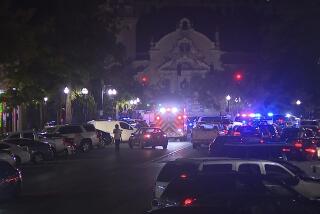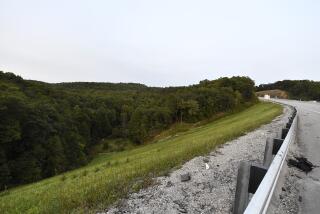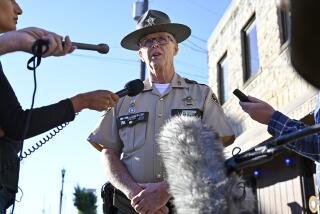Police Command Post Abuzz in Race to Find Sniper
- Share via
ROCKVILLE, Md. — In calmer days, police used the card table at the headquarters of the Montgomery County Police Department to cut birthday cakes. But now the table--and every other available piece of furniture in the two-story brick building--has been taken over by the nearly 200 federal, state and local investigators who are in a desperate race to find the killer who is shooting people at random in the Washington, D.C., area.
Before last week, this police department had just two squads dedicated to homicides and other major crimes, 18 officers in all. But in one deadly day, the number of murders this year jumped from 20 to 25--and a sleepy bedroom-community police department found itself inundated with work, leads and help.
Since then, the elusive sniper has killed another man on a street corner in Washington, shot a 43-year-old Virginia woman as she was loading packages into her van and critically injured a 13-year-old Maryland boy who likes math. Wednesday night, he struck again, killing a 53-year-old engineer at a gas station in Virginia near a Civil War battlefield.
After Monday’s shooting of the schoolboy, Montgomery County Police Chief Charles A. Moose formally asked the federal government for help, citing a federal law that allows the Justice Department to investigate local crimes involving serial killings.
Atty. Gen. John Ashcroft immediately vowed to keep the federal resources flowing.
So many agents from so many agencies have flooded the command center at police administration headquarters that some are working while standing.
“I’ve seen people in this building I’ve never seen before,” said Officer Derek Baliles, a department spokesman.
There is no room for more tables and chairs. Phone lines have been added to handle the crush.
But Moose remains in charge, appearing several times a day on live television to brief the media and taking advice from the more experienced hands around him. “It would be much more difficult” if his 1,074 officers had to handle the case on their own, the chief acknowledged.
The department isn’t even fully staffed. A banner outside proclaims, “NOW HIRING.”
But for a low-crime department, the chief and his investigators have earned the respect of the outsiders.
“It’s his show and I have 100% confidence in him,” said Gary M. Bald, the FBI special agent in charge of the Baltimore regional office. Bald, like dozens of other federal agents, has been involved in the investigation since day one.
The FBI showed up last Friday with its own computer system, which is operating 24 hours a day. “They rolled the system in on wheels,” Baliles said.
As tips pour into the department, which has set up a special phone number to handle the calls, officers entered them on a standardized form, which is then typed into the FBI’s Rapid Start computer program. The FBI used the same case management program after last year’s terrorist attacks.
“It’s very effective,” the FBI’s Bald said. “It helps prioritize tips and track leads.”
So far, more than 8,000 tips have poured in, of which at least 1,600 have been ruled worthy of further investigation. “They’ve provided forms for us,” Baliles said. “We’re copying and copying and copying.”
The FBI has also provided agents, helicopters and a geographical and psychological profile of the killer, which is constantly evolving. “From my experience generally, profiles are never complete,” Bald said. “They’re a work in progress.”
Agents from the Secret Service and U.S. Marshals Service are also providing help, acting as investigators, uniformed security or just plain administrators.
The federal Bureau of Alcohol, Tobacco and Firearms has lent about 100 agents to the investigation--as well as five Labrador retrievers trained to sniff out gunshot residue.
“Agents are developing leads. Forensic examiners are working on the case. Our ballistics identification network is working on this,” said Mike Bouchard, the ATF special agent in charge of the Baltimore regional office.
ATF agents are trying to see whether any of the ballistic evidence taken from the shooting victims matches any other shooting across the country, Bouchard said. The ATF national lab is in Rockville, not far from the police command post.
On Monday, ATF agents went to the hospital where the boy who was shot was taken, to get the bullet fragments that surgeons had removed from his chest, then hurried them back to the lab for testing to see whether they matched the other Maryland shootings. They did.
Investigators believe the sniper is using an assault or high-powered rifle that shoots .223-caliber bullets, rounds so deadly that they can penetrate bulletproof vests.
Their only known lead so far is a witness account of a six-wheeled white truck seen speeding from one of the early crime scenes. Police are trying to find out who owns similar trucks in the Washington area, what companies use them and who is licensed to drive them. And they are combing through jail and prison records, trying to see whether anyone who was recently released fits the killer’s profile.
The federal help has given the local investigators needed rest, Moose said. “Each investigator is now able to spend a little more time with his thoughts, a little more time to process information.”
How difficult is this case? “It’s difficult enough that we haven’t got the person,” the ATF’s Bouchard said.
If the killings go beyond the Washington area, the FBI could end up in charge of the whole probe. “If it goes multistate, across the country, that’s bigger than we can handle,” Baliles said.
More to Read
Sign up for Essential California
The most important California stories and recommendations in your inbox every morning.
You may occasionally receive promotional content from the Los Angeles Times.










